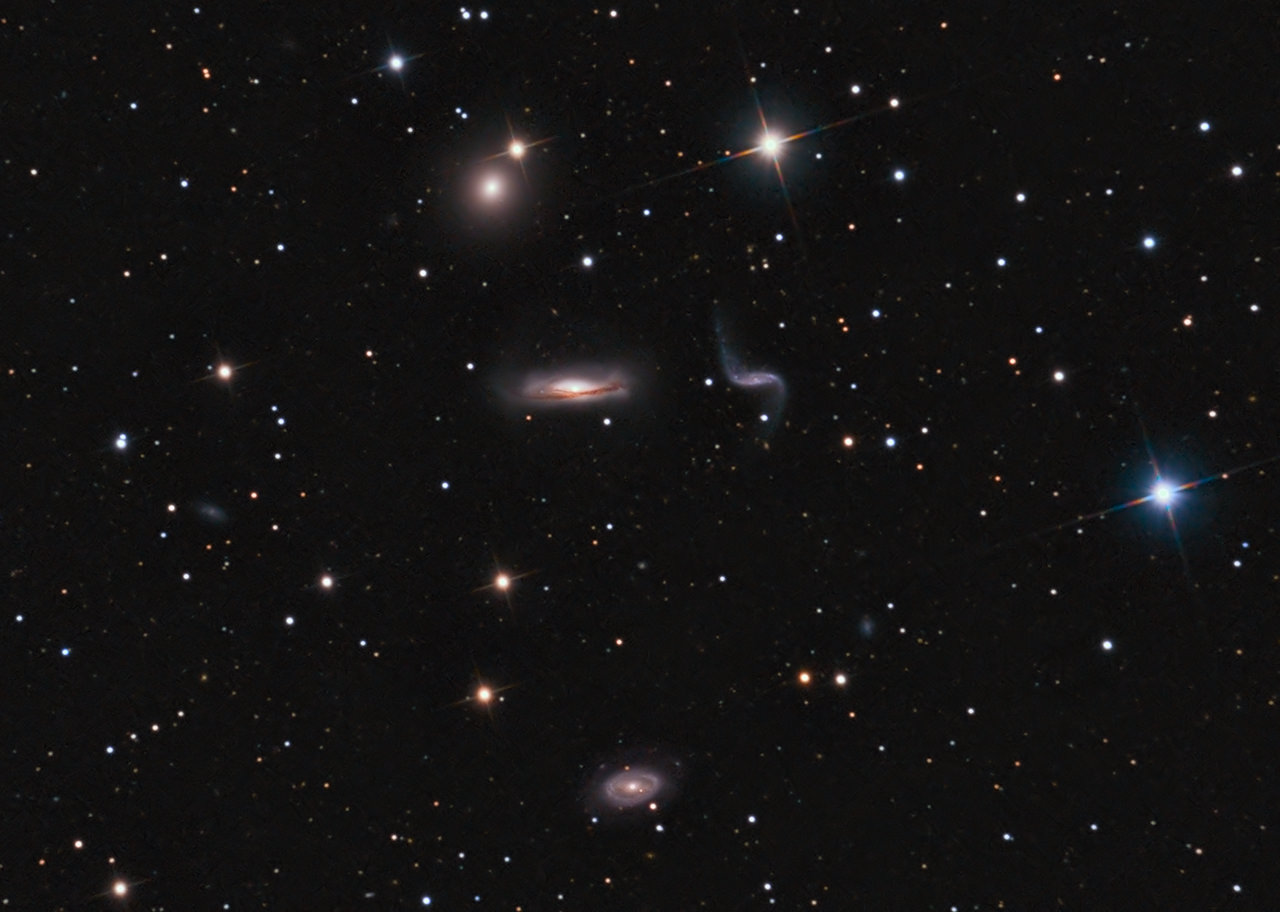[/caption]
If you turn your telescope towards Leo, you just might discover a group of galaxies which reside close to our own Milky Way – Hickson Compact Group 44. At only 60 million light years away, this diverse and interesting collection has quite a story to tell!
Some three decades ago, Canadian astronomer, Paul Hickson set about the task of completing a list of 100 galaxies clusters. But, they couldn’t be just any set of galaxies – they had to be isolated, compact and within a limited magnitude range. His purpose was to study them for unusual redshifts among their members – and to improve our knowledge of galactic evolution. From his work came the theory that perhaps all well-known galaxies once emerged from such clusters and this hypothesis also contributed mightily to our understanding of dark matter as well. What Hickson left us with is a legacy of beautiful objects that challenge not only the telescope – but the mind as well.
In this photo done by Warren Keller, you will see from 11 o’clock: NGC 3193; 3190 and 3187 at center, and 3185 at 6 o’clock. A closer look reveals two tiny galaxies PGC (Principal Galaxies Catalog) 2806871 near 8 o’clock and PGC 86788 near 5 o’clock. As you can see, this group is an interesting collection of galaxy types – from barred spiral to elliptical in structure… close enough to share material as they gravitationally interact.
While some of you may recognize the three principle players in this galactic act as the “Leo Trio”, take a closer look at barred spiral NGC 3190. It was first discovered by Sir William Herschel in 1784 and was home to two supernova events in 2002. Lurking at its heart is an active galactic nucleus (AGN), home to a super-massive black hole. While the discovery of the rare Type Ia supernova was unusual enough, adding a second similar supernova event occurring simultaneously made this galactic action even more rare. Two young x-ray emitting events, set against a record breaking amount of obscuring dust!
Perhaps the interaction with nearby NGC 3187 is the root cause? It is, after all, evolving. Studies indicate an evolutionary sequence for Hickson compact groups in which the amount of diffuse light increases with the dynamical evolution of the group. “Compact groups are associations of a few galaxies in which the environment plays an important role in galaxy evolution.” says J. A. L. Aguerri (et al). “The low group velocity dispersion favors tidal interactions and mergers, which may bring stars from galaxies to the diffuse intragroup light. Numerical simulations of galaxy clusters in hierarchical cosmologies show that the amount of the diffuse light increases with the dynamical evolution of the cluster.”
While this group of galaxies is evolving and interacting together across vast distances, you can collect them all in the same eyepiece view found about halfway between Gamma and Zeta Leonis (RA: 10h18m00.4s Dec: +21°48’44”). They are by no means easy, the faintest of which is magnitude 13, but it can be accomplished with a minimum of a 150mm telescope under dark, clear skies.
Remember, the beauty is in the challenge… and the discovery!


The Hickson groups are some of my favorite targets with my 18″ f/4.5 Obsession.
It just blows me away when I contemplate how many kazillion stars I’m looking at in one small sliver of the sky and how many potential aliens are out there in that place looking back at me!
Thanks for not just rehashing the same old “M”s!
Can someone tell me if my Orion XT10″ @F4.2 is big enough to see the Leo triplets?
I dought that it is big enough to see the faint ones that show up in the photo. I keep meening to try to find them but I seem to be stuck in a rut looking at easier targets such as nebulas.
with good sky conditions, your orion scope is more than adequate. but just remember a few things… poor seeing conditons, such as high, thin clouds you might not even notice can and will rob you of the faintest of the four. also remember they will be small “smudges” that require averted vision to distinguish… and that they won’t just “fall” into the eyepiece the way a brighter object does.
but don’t be discouraged!!! little tricks, like using a lower magnfication eyepiece to locate and then working your way up to higher magnification to darken the field and draw out details will help. looking in the eyepiece while slowly “sweeping” the area also helps. once you locate one, the others will fall into place for you.
and good for you for using a manual scope! while it doesn’t offer instant gratification and often makes the user wait through many observing sessions before they finally locate a challenging object, it also makes you feel extremely “worthy” of having found it.
just remember when the “easy” targets weren’t so easy and how far you have come!
I own a Hardin 10″ Dob that is a clone of your Orion. I’ve observed the Leo Triplet more times than I can count using that scope. I’ve also easily seen them in my 4.5″ f/9 Orion dob too. But I’m also observing from my pasture in rural NC far away from city lights.
Tammy is right – when hunting galaxies they key is good (clear and steady) and dark skies – period. Find a local astro club that has access to a dark sky site and/or find a nearby star party – for a few bucks in gas, you’ll increase what your scope can do by 10 fold!
If you want a list of these groups, you can query the database here. http://heasarc.gsfc.nasa.gov/db-perl/W3Browse/w3table.pl?tablehead=name%3Dhcg&Action=More+Options